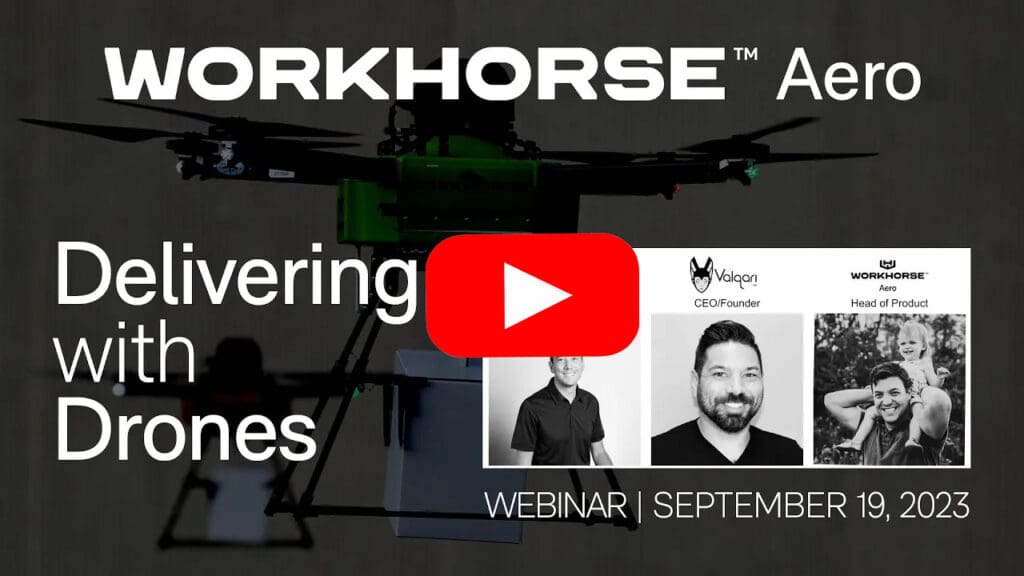In our recent webinar, Randall Warnas, Workhorse Aero VP of Sales and Marketing, and Jarod Patton, Principal Engineer, provided an update on commercial drone technology. Joined by special guest Ryan Walsh, CEO of Valqari, the group discussed the integration of Valqari’s patented Drone Port technology with Workhorse Aero’s WA4-100 delivery drone.
Dive into our Q&As below, and be sure to watch the webinar replay for a firsthand look into the future of commercial drone delivery.
What are the challenges for operating Workhorse aircraft in the winter?
We have performed initial environmental testing on the WA4-200 to include cold-soaking the aircraft. Our WA4-200 has a lower storage temperature limit of 14 degrees Fahrenheit. We will be performing the same testing for the WA4-100 imminently as part of our 44807 and validation testing program. Currently, the operating temperature is based on a component limit of 32 degrees Fahrenheit .
What protections are in place to ensure the drone delivering packages isn’t hacked into and control taken over?
We have built-in security protection and monitoring across our communications infrastructure and encrypted communication links.
What changes to the packages themselves must be made to make drone delivery possible?
We designed a one-time-use box that packages can be placed in up to 10”x10”x8”. This allows for smaller packages or loose goods to be delivered. We performed other testing using zip-ties around existing packages during our early design testing and determined that our current solution significantly improves delivery reliability.
How can Workhorse products be used for agricultural applications?
We have begun a design to develop a universal sensor mounting system for the WA4-200 Falcon. It is currently on our roadmap for 2024. Our team has experience with using LIDAR in support of our agricultural scanning operations.
How does Workhorse work through deconflicting airspace in controlled airspace for deliveries?
Our RPICs and visual observers are all Part 107 certified. We have well-defined flight operations processes and procedures that outline everything from pre-flight inspections to flight planning and mission operation. We follow Part 107 rules and regulations in which whatever airspace we are operating, including obtaining appropriate waivers and coordination with 3rd parties as required. Currently, our operations are within visual line-of-sight, so real-time deconfliction occurs on an as-needed basis following Part 107 rules.
We are also working with multiple enabling technology providers to improve visual line-of-sight and beyond visual line-of-sight operations, as well as working closely with the FAA.
What does the relationship between UPS and Workhorse look like?
Workhorse has a long history of working with UPS throughout the development of the WA4-100 “Horsefly” drone. The UPS Flight Forward team is currently working with our aircraft and has expressed satisfaction with its performance. We have provided them with our standard training, and they have been operating the system on their own. We continue to collaborate with UPS as we go through the 44807 process.
Can you change the color coding in the Squadron app for those with color blindness?
As the Squadron application is a completely Workhorse-developed product; we have the ability to tailor the interface as needed to meet the market needs. This has not been requested to date and is not currently on our development roadmap.
What are the implications of drone delivery for urban planning and the design of future cities?
As drone delivery and Smart City technology continues to progress, urban planners will need to take these capabilities into account. Complementary technologies, such as smart mailboxes or dedicated delivery areas on individual properties, are examples of concepts that will likely be taken into account.
Where are you currently focusing efforts for selling delivery drone technology?
Solutions within logistics are demanded globally, and some environments lend themselves to benefit more from drones than others. We have strong relationships and pursuits in the United States, but we are looking strategically abroad to find the right partners with an openness to innovation, accommodating aerospace regulations, and partners who can facilitate implementation.
How does Workhorse participate in air traffic control issues to enable future BVLOS operations?
We are collaborating with several enabling technology providers and participating in initiatives in the areas of drone-tracking Radars, aircraft telemetry transmission, other supporting infrastructure technology concepts, and staying tightly connected with the FAA. The WA4-100 design supports scalability to BVLOS operations and one-to-many pilot-to-drone ratios once the technology and regulations are ready.
If you would like to discuss Workhorse Aero products, or if you have ideas regarding collaboration, use our contact form or email [email protected]
